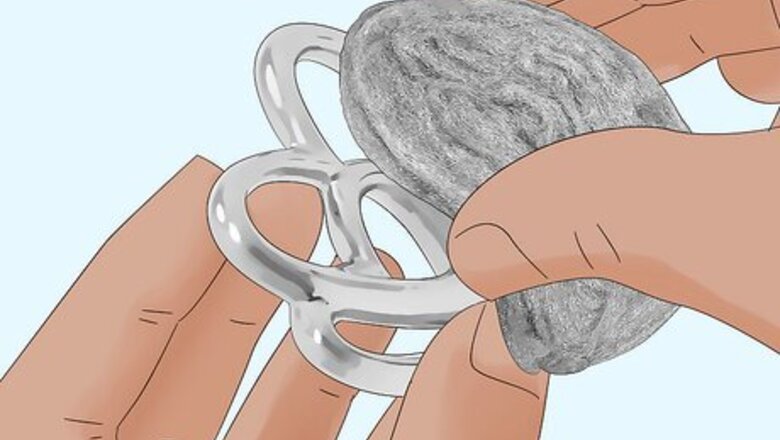
views
Vinegar (Natural, Soft Patina)
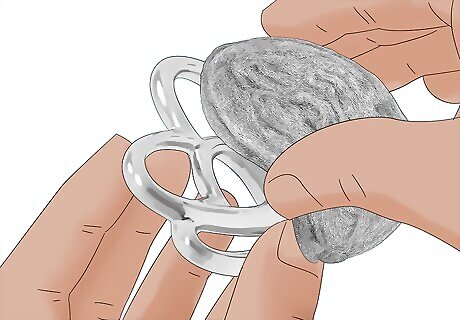
Scuff the steel with steel wool or sandpaper. Use the abrasive material to scuff the parts of the stainless steel that you want to age. Scuffing the steel will create a more age-worn appearance. It also removes any protective coating (if it exists), which allows more of the vinegar to penetrate and work its way through the metal. Vinegar is ideal for softer stainless steel objects if you want to create a subtle, natural look. Steel wool pads will usually create deeper scratches, so if you want to create more subtle wear, use sandpaper instead. Choose a medium- to heavy-grit sandpaper for best results.
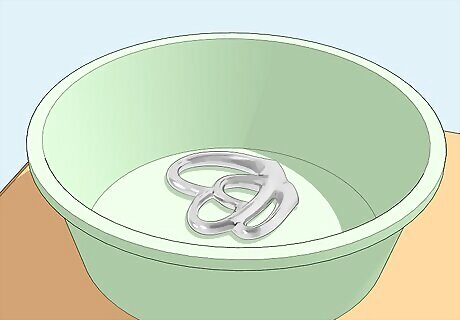
Place the stainless steel piece in a large plastic container. Plastic doesn’t normally react with vinegar, so it’s ideal for this. You can also use a ceramic bowl for smaller items. Place the prepared steel item in a plastic bucket or in another similar container made of non-reactive material. All sides you wish to antique should be exposed. If one side is covered or hidden against the side of the container, the vinegar may not work as effectively there.
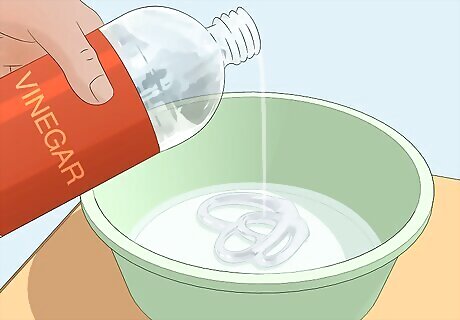
Submerge the stainless steel item with vinegar. Pour enough vinegar into the container that you cover the item entirely. If you need to weigh the item down to keep it submerged, set another bowl or container on top to push the item down a bit. If you want to be extra safe, wear safety goggles and rubber gloves when handling vinegar. Vinegar is a mild acid, so it can sting if it splashes into your eyes. Vinegar can also be a mild irritant if you have sensitive skin or if your skin is submerged for prolonged periods. Every side touching the vinegar will be affected. Any type of vinegar should work for this project, but white distilled vinegar is recommended since it is fairly cheap and easy to come by.
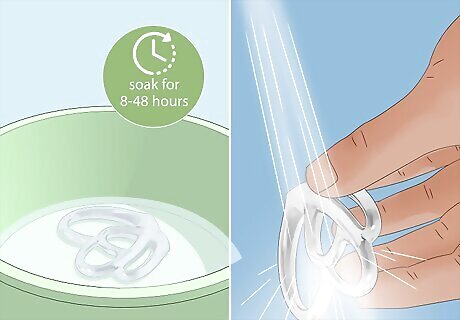
Let the steel soak for 8-48 hours and rinse it off with water. The longer the steel soaks, the more antiqued the item will look. Keep the steel piece soaked in the vinegar for at least 8 hours to see how the patina has developed and take it from there. Remove the item with a gloved hand and rinse it under water whenever you’re happy with the look. The piece should look subtly aged and worn as soon as you remove it. When you remove the piece, rinse the vinegar away with clean water and dry it with clean towels.
Ferric Chloride (Etched Steel)
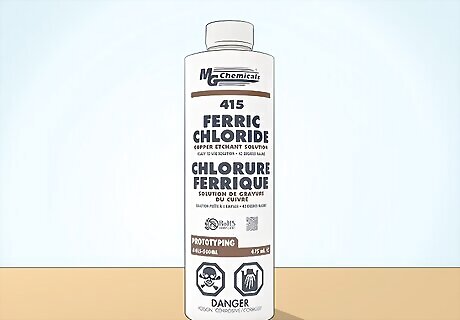
Purchase a copper or steel etching solution. Look for a product that contains ferric chloride. Ferric chloride will wear away layers of stainless steel to create a scratchy, etched look, and any product with ferric chloride in it will do the trick. A lot of metalworkers and DIY enthusiasts find muriatic acid to work as well—especially if you want a rusted look—but we haven’t been able to test it. The process should be functionally identical to the process outlined here if you want to give it a try!
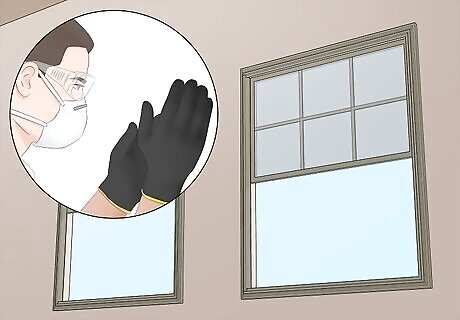
Work in a well-ventilated area and wear safety gear. Go outside or open all the windows and turn a fan on. Put on protective rubber gloves, wear protective goggles, and throw on a dust mask. Ferric chloride is a strong acid, so wear long sleeves and pants if there’s a chance you’ll get it on your skin.
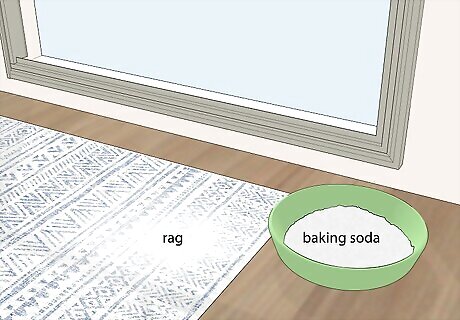
Lay out a rag and set some baking soda aside. Ferric chloride will stain anything it touches, so put a scrap rag down to protect whatever surface you’re working on. Also, set some baking soda out. Baking soda neutralizes ferric chloride, so if there’s a spill or you make a mistake, it’s important to have a neutralizing agent nearby.
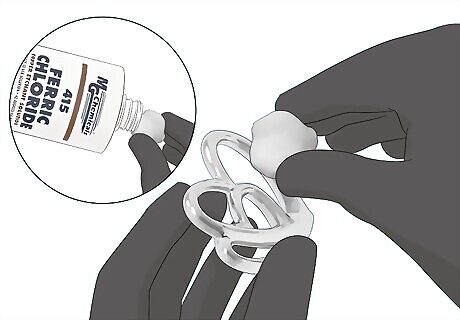
Moisten a cotton ball in ferric chloride and rub the item. Open the ferric chloride and set a large cotton ball on top of the open container. Turn the container over quickly to moisten the cotton ball. Then, start dabbing or rubbing the stainless steel wherever you want the material to age. For a larger surface area, feel free to use a rag instead of a cotton ball. Keep reloading clean cotton balls and rubbing them wherever you want the patina to develop. Toss the cotton balls in the trash when you’re done. The ferric chloride won’t interact with a plastic garbage bag or plastic bin. An essential note on the color: Ferric chloride will create a dark buildup material on the steel as you work. This dark material, called smut, will be permanent if you let it dry. If you like the color, great! Leave it alone as it develops. If you don’t, remove it as you work.
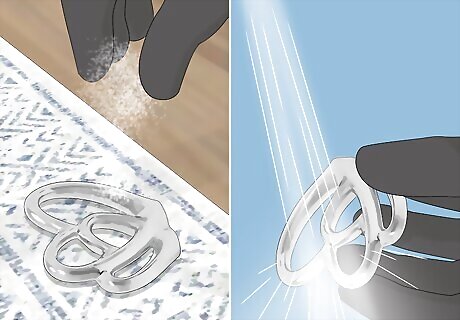
Set the etching with baking soda and water. Stop applying the ferric chloride once you’re happy with the result. If you want the smut to stay where it is, let the item air dry before rinsing it off. If you don’t, pour baking soda all over the item, wait a few minutes, and rinse the soda and chloride off. Let the item air dry and you’ll be left with a beautiful, antiqued material.
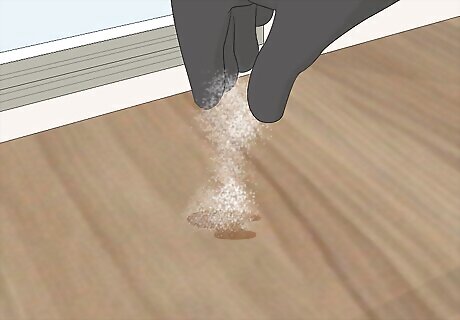
Pour baking soda on any spills or mistakes as you work. If the chloride ends up anywhere you don’t want it to be, pour a liberal amount of baking soda over it. This will instantly kill any chemical reactions. Let it dry out and wipe it away with a paper towel when you’re done.
Heated Staining (Blackening)
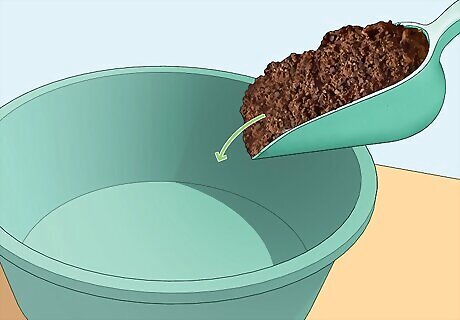
Fill a container with warm, moist coffee grounds. Don’t use spent coffee grounds. Just fill a container with fresh coffee grounds and mix in a few spoonfuls of water so that the coffee is damp. For small, narrow objects (like screws), you can fill a small cup with your prepared grounds. For larger objects, coat the bottom of a shallow tray with the grounds, instead. Wear some heat-resistant gloves if you’re worried about accidentally burning yourself.
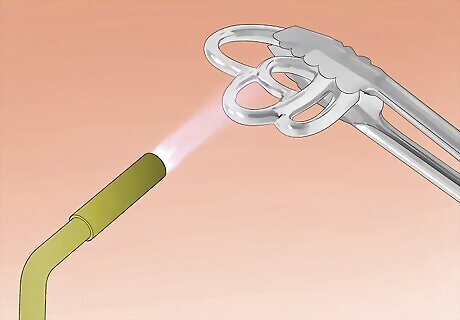
Heat the steel using a torch or lighter. Hold the metal object with tongs or a vice, then light a butane torch or ignite a lighter. Carefully pass the flame over the object, heating it thoroughly wherever you want the patina to develop. Continue rotating and passing the flame over the stainless steel object until the metal begins to darken in color.
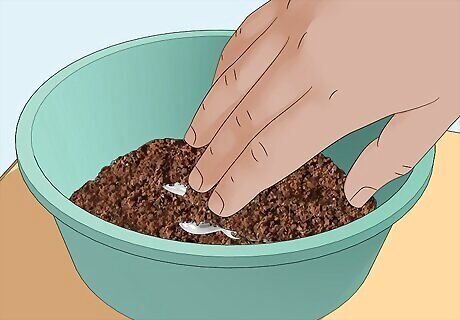
Bury the steel in the coffee grounds once you get a patina. As soon as the steel object darkens to your liking, quickly dip the heated portion into the prepared coffee grounds. Hold it in the grounds for 15 to 30 seconds. The moisture in the coffee grounds should help to cool off the metal. Theoretically, the steel should be safe to touch once you remove it from the grounds, but you should still proceed with caution. In addition to cooling off the metal, the coffee should help dye the stainless steel, giving it the appearance of antiqued metal.
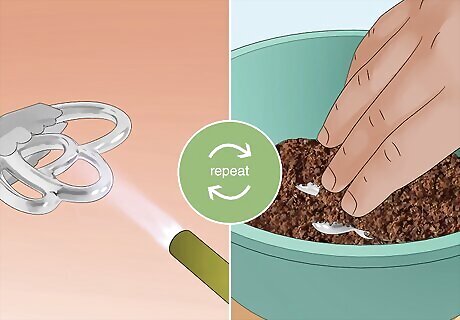
Repeat the process as needed. If you want to dye the steel even darker, reheat it and submerge it into the coffee grounds again. Keep heating and soaking the item in moist coffee grounds until you’re happy with the look of the item.
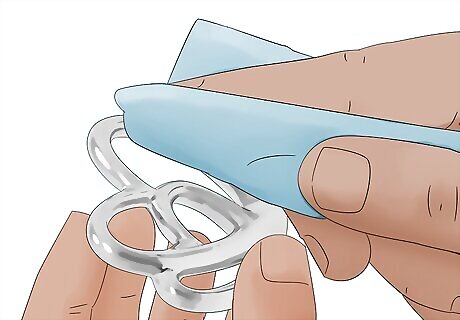
Polish the steel with a clean microfiber cloth when you’re done. Once you're satisfied with the results, quickly polish the steel object by rubbing it with a soft cloth. This will remove any coffee residue and dirt to leave the perfect patina. Wait until the object is cool enough to touch before polishing it.
Acrylic Painting (Custom Finish)
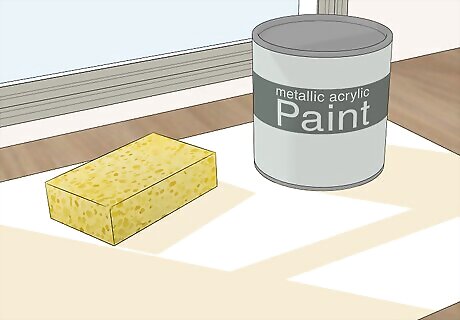
Get metallic acrylic paint, a sponge, and cover your work surface. Get metallic acrylic paint, a paintbrush, and a wet sponge. To prevent things from getting too messy, cover your work area with plastic sheets or newspaper. If you want a more permanent coat, use an epoxy paint. Just be aware, epoxy is much less forgiving than acrylic, so it’s not a great option if you aren’t confident you want to permanently paint it.
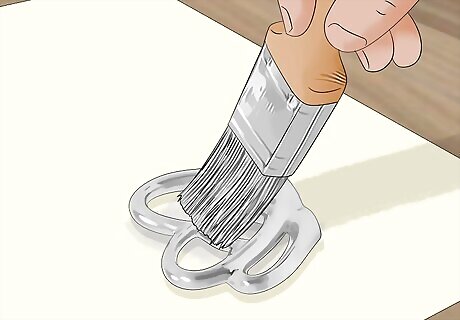
Brush on the first coat of your paint. Dip the paintbrush in paint and apply the paint to the stainless steel object using even strokes. Apply the paint along the grain of the steel. Cover the entire surface you wish to antique, but do not allow the paint to dry. Pour the paint into a disposable paint dish for easy access.
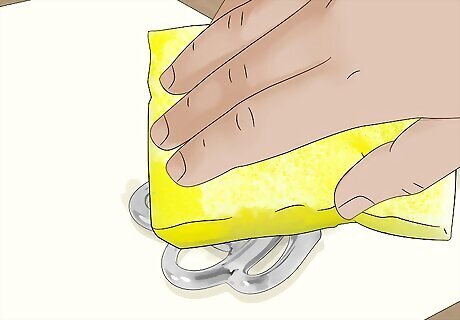
Sponge away some of the paint. Remove some of the paint, but don't wipe all of it away. Much of the paint should remain after you complete this step. Dab at the applied paint using the wet sponge. Work your way around the surface, essentially “messing up” the perfect coat of paint you just applied. Using a wet sponge instead of a dry sponge should prevent the pattern of the sponge from imprinting itself into the paint. As you dab away at the paint, you should notice some spots where the paint smears and others where the paint develops a splattered appearance. Both effects are what you need to retain.
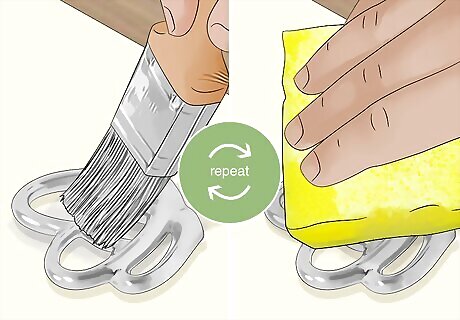
Keep applying paint and removing it until you like the look. Work back and forth between the previous two steps. Apply paint with your paintbrush, then dab some of the paint away with your wet sponge. Keep building up the look you’re going for. Keep the sponge damp but rinse it out when it gets overloaded with water. You can also alternate between different colors and shades once you’ve built up a base layer you’re happy with.
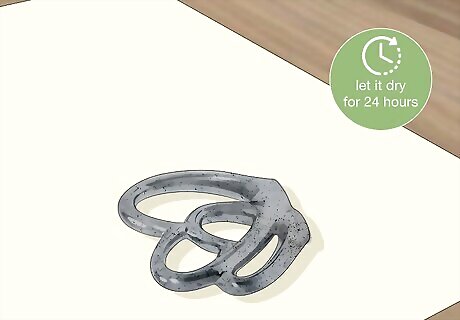
Let the paint dry for 24 hours. Set the stainless steel piece aside and allow it to dry completely before handling it further. Once the item is dry, you can either apply additional coats or leave the item as it is. Examine the dry piece. Most of the natural metal should show through beneath the coat of paint. Determine whether or not you are satisfied with these results. The paint will eventually peel off—especially if you’re handling the item every day. For small decorative items, it may be years before you need to reapply the paint, though.

















Comments
0 comment